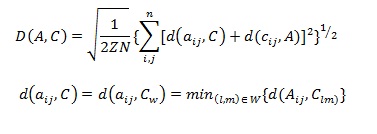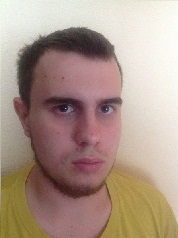Abstract
Content
- Introduction
- 1. Statement of a problem and article purpose
- 2.Review of Existing methods, algorithms, and packages of software solutions of similar tasks.
- 3.Description of methods and algorithms
- 4.Conclusions
- References
Introduction
It is well-known scene from a science fiction movie: the hero comes to the door and opens the door to hear it. This is one of the most vivid demonstrations of convenience and reliability of biometric technology for access control. However, in practice it's not so simple. Today, some firms are willing to offer consumers access control using biometric technology.
1. Statement of a problem and article purpose
Traditional methods of identification of the personality at the heart of which there are various ID cards, keys or unique data, such as, passwords are not reliable in that degree which is required today. Attempts of use of biometric technologies for safety systems became a natural step to increase of reliability of identifiers.
Process of automatic identification of persons assumes creation of the hardware-software means, the capable person at the minimum intervention carries out high-quality identification, using only the image of the face of the person. The urgency of this task, and also its preference in comparison with other means of identification of the personality (for example, identification on fingerprints or on an eye retina) is that there is no need of direct contact of system and the person. The face of the person in itself contains unique information for carrying out faultless identification.
The purpose of this article are the review, comparison of various methods of definition of biometric characteristics of the person, for a method choice for the purpose of creation of the automated system.
2. Review of Existing methods, algorithms, and packages of software solutions of similar tasks.
Now there are four main methods of recognition of the person:« eigenfaces», the analysis of "distinctive features", the analysis on a basis of «neural networks», a method of «automatic processing of the image of the person».Все these methods differ with complexity of realization and the application purpose.
«Eigenface» can translate as «own person». This technology uses two-dimensional images in gradation gray which represent distinctive characteristics of the image of the person. The eigenface method are often used as a basis for other methods of recognition of the person.
Combining characteristics of 100-120 «eigenface» it is possible to restore a large number of persons. At the moment of registration, «eigenface» of each specific person is represented in the form of a number of factors. For a mode of establishment of authenticity in which the image is used for identity check, the "live" template is compared to already registered template, for the purpose of definition of factor of distinction. Distinction degree between templates also defines the identification fact. The eigenface technology is optimum when using in well shined rooms when there is a possibility of scanning of the person full face.
A technique of the analysis of "distinctive features" - most widely used technology of identification. This technology is similar to "Eigenface" technique, but is more adapted for change of appearance or a mimicry of the person (smiling or frowning person). In technology of "distinctive features" tens characteristics of various areas of the person, and taking into account their relative location are used. The individual combination of these parameters defines features of each particular person. The face of the person is unique, but is rather dynamic, since the person can smile, release a beard and moustaches, to put on points - all this increases complexity of procedure of identification. Thus, for example, at a smile some shift of parts of the person located about a mouth that will cause in turn similar movement of adjacent parts is observed. Considering such shifts, it is possible to identify unequivocally the person and at various mimic changes of the person. As this analysis considers local sites of the person, tolerances can be in limits to 25 ° in the horizontal plane, and approximately to 15 ° in the vertical plane and demands rather powerful and expensive equipment that respectively reduces extent of distribution of this method.
In a method based on a neural network, characteristics of both persons - registered and checked are compared on coincidence.« Neural networks» use the algorithm establishing compliance of unique parameters of the face of the checked person and parameters of a template, being in a database, the greatest possible number of parameters is thus applied. In process of comparison discrepancies between the person checked and a template from a database are defined, then the mechanism which defines degree of compliance of a checked face by the corresponding weight factors to a template from a database is started. This method increases quality of identification of the person in difficult conditions.
A method «automatic processing of the image of the person» - the simplest technology using distances and the relation of distances between easily defined points of the person, such as eyes, the nose end, mouth corners. Though this method not so powerful as «eigenfaces» or «a neural network», it can be rather effectively used in the conditions of weak illumination.
All methods considered above are effective, but, or difficult realized or insufficiently exact.
3. Description of methods and algorithms
For research methods of definition of the photo on the basis of geometrical characteristics of the face of the person are chosen.
In work [1] the approach based on geometrical characteristics of the person is considered. In this work the database of persons consisting of 188 photos (on four photos for each of 47 people) which images (photo) turned out by means of special CCD-kamery was used. The distance from object to the chamber during shooting was not accurately fixed, therefore change in scale made to 30 %. Authors of this method put the following requirements to algorithm:
- maximum simplicity of estimated algorithm;
- influence of lighting should be minimum;
- the minimum sensitivity to a mimicry
An example of the flow chart can be seen in the animation 1

Animation 1 - Example flowchar
(animation: 3 cycles of repetition, to preview the update page, 76 Kb)
The first key moment which defines quality of work of algorithm as a whole, preprocessing or image rationing for the purpose of improvement of yarkostno-contrast characteristics is. The taken characteristic points should be нормированы for ensuring invariancy in relation to a position (arrangement) of the person, scale and an angle of rotation. Other key moment is procedure of definition of a set of characteristic points. The considered geometrical method relies on property of bilateral symmetry of the person. The set of the relations of distances between such characteristic points of the person as eyes, a nose tip, the mouth center is used. The algorithm of definition of characteristic points is based on an integrated projection of the image. The projective analysis is carried out over the binary image received by a way of application of operator Laplas. Applying the above-stated algorithm characteristic points of an arrangement of eyes, a nose, eyebrows, a mouth were received, and also the face contour on the basis of what 35 geometrical signs were allocated was defined. Using, to the persons described in this way, Bayes's qualifier authors of this method achieved 90%ного recognition on a database of 47 people.
In work [2] the geometrical method of identification of the persons, based on geometrical distance between key points is also offered. Similarity of persons, according to this method, is estimated at some stages, operating by a principle “from rough to exact”. The set of key points for each person at first is defined, then kl of the images close on geometrical characteristics to the classified person is selected approximately; kl is defined so:

where N - quantity of the portraits containing in a database.
After that the stage of normalization of the image for on - the following calculation of correlation between the central obverse parts of kl of images and an obverse part of the identified image is carried out. Receiving k2 of images from kl selected will be result:

Key points are defined automatically, but for carrying out more exact identification also manual selection of points is possible. In the experiments which are carried out by authors of this geometrical method the set from 37 key points was used. The example of the received geometrical points is presented on image. 1

Fig. 1 Example of a set of geometrical key points.
For a problem of identification it is necessary to execute a stage of association of points in segments, perimeters and the areas of various figures - definition of a representative set of characteristics. Further this set can be optimized for achievement of more quality identification. Process of identification consists in definition of the "closest" image in relation to the identified image with use of the Euclidean metrics. The hypothesis which has been put forward by authors of this work, following - if two images contain almost identical information, they should contain a set of pixels with close values of intensity.
And it is possible to present the image as a discrete surface:

The distance from each pixel of one image to the closest pixels of other image reflects, so-called, local difference. Calculating a set of local differences and accumulating them in global value of difference, the final assessment of similarity of images is formed. Global value of difference of two images And and With can be determined by the following formula:

and W - a square watch window of the size (2w+1) x (2w+1) aligned in a point (i, j) Page images.

Fig. 2 the Screen form of the automated system.
Experiments on determination of quality of recognition were carried out on the database of persons made by Olivetti Research Lab. Quality of recognition made 98,5 %.
4. Conclusions
For an assessment of the most optimum method it is necessary to define parameters on which we will carry out the comparative analysis. The first parameter - percent of the correct recognition (PPR): a range from 0 to 100 %; the second - relative temporary cost (OVS) which shares on category: high, average, low also reflects temporary expenses of work of system; the third - complexity of system (high, average, low) and the fourth parameter - possibility of training of system (yes or no). In table all above described methods are provided and estimated.

The table shows that the face recognition percent 2м a method is more effective, and yields more exact results. The mathematical methods described in this article and algorithms will help to create system which can distinguish faces on the basis of biometric parameters of the person. Result of work of system is recognition of the person according to his photo.
References
- Brunelli R. and Poggio T.Face recognition: features versus tem- plates// IEEE Trans. on Pattern Analysis and Machine Intel.- 1993. — Vol.15. — No 10. — P. 1042-1052.
- StarovoitovV.,SamalD.,G.Votsis,and S.Kollias “Face recognition by geometric features”, Proceedings of 5-th Pattern Recognition and Information Analysis Conference, Minsk, May 1999.
- Самаль Д.И., Старовойтов В.В. - Подходы и методы распознавания людей по фотопортретам. - Минск, ИТК НАНБ, 1998. - 54с.
- Самаль Д.И., Старовойтов В.В. Методика автоматизированного распознавания людей по фотопортретам // Цифровая обработка изображений. - Минск:ИТК, 1999.-С.81-85.
- Самаль Д.И. Построение систем идентификации личности на основе антропометрических точек лица // Цифровая обработка изображений. - Минск:ИТК, 1998.-С.72-79.
- Методы компьютерной обработки изображений / Под Ред. В.А. Сойфера. - М.: ФИЗМАТЛИТ, 2003.-784с.
